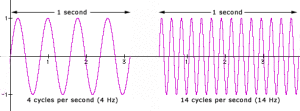Since I began research on the subject of musical frequencies and how they affect us, I started listening to the sounds and pitches found in nature, the buzzing of power tools, the humming of household appliances, and even people singing without the aid of an accompanying instrument. When I found that my household appliances were “in tune” with the Prophetic Musical Journey CD’s (where I lowered the concert pitch from the standard A=440 to A=432), I began to wonder about the natural voice.
 Although I’m an instrumentalist, I did sing in choir all the way through high school and college. I had flashbacks of many choir directors rolling eyes at us after we’d finishing singing this beautiful acapella song… We would all look eagerly as they’d go over to the piano with a sinister look in their eyes. (I really think they enjoyed this part). With all of us staring at the piano, they’d play the starting pitch. We’d groan each time to find that we’d gone flat by nearly a quarter step at times! This scenario was repeated frequently, even in experienced choral groups. This seems to be an inherent problem so… my curiosity got the better of me. Why does this happen?
Although I’m an instrumentalist, I did sing in choir all the way through high school and college. I had flashbacks of many choir directors rolling eyes at us after we’d finishing singing this beautiful acapella song… We would all look eagerly as they’d go over to the piano with a sinister look in their eyes. (I really think they enjoyed this part). With all of us staring at the piano, they’d play the starting pitch. We’d groan each time to find that we’d gone flat by nearly a quarter step at times! This scenario was repeated frequently, even in experienced choral groups. This seems to be an inherent problem so… my curiosity got the better of me. Why does this happen?
In thinking back to these choral experiences, I came up with a theory that people tend to naturally sing at a lower concert pitch when not given a starting pitch (piano, pitch pipe, etc.). Things in nature and even my household appliances appeared to “entrain” themselves to the concert pitch A=432. Would the natural singing voice do the same thing? Enquiring minds wanted to know.
We’ll take a moment from our regular scheduled article to give a couple definitions… “Concert pitch” refers to tuning musical instruments so all notes sound decent when more than one note is played at the same time. In order for instruments to sound good together, they must be tuned to the same concert pitch. Equal temperament requires that the distance between every note be exactly the same from the bottom to the top of the piano (or any instrument for that matter). Equal temperament was not standard until there were devices to provide these exact measurements. Until then, musicians used just intonation, mean-tone tuning, well-tempered tuning, among others. Everything had to be done by ear (or tuning forks), which meant that tuning an instrument could never be exact.
Now, back to the article… (brainiac break over)
My office is next to the choir room. One day, while listening to the choir’s warm-up routine, I got the idea to go onto YouTube to compare concert pitches of a variety of singers. The goal? I wanted to see if people around the world sing in a similar concert pitch. Fortunately, the tuner on my phone will pick up the exact pitch (in Hertz) that is sung or played. It works well enough to pick up “notes” of tools and appliances. It even picked up the buzzing of the transformer sub-station across from my friend’s house. That pitch? It was an F-sharp in the A=432 concert pitch.
I listened to 29 videos of acapella singing, writing down the frequencies that my tuner registered. Some of the videos had poor sound quality so the tuner could only pick up one or two of the main frequencies (home pitch) sung by the group or soloist. I chose videos from countries that are probably not used to western music and our standard concert pitch of A=440 (mostly African countries with a couple from Asia). After I kept running across Native American videos, I went ahead and listened to a few of them simply because their music is very different than rock, pop, or even classical music. I expected my results would be skewed because most Native Americans are fairly well immersed in the American culture, including our music.
 Eventually, I looked up each frequency and tried to find which concert pitch was the closest match. There are several frequency charts online that show frequencies from a number of different concert pitches (all in equal temperament). Knowing that equal temperament is slightly out of tune, I was not necessarily looking for a perfect match. (The subject of equal temperament is reserved for another article.) Singers don’t necessarily conform to equal temperament so I knew some of the pitches would probably be plus or minus 4 – 5 cents from what I found in the frequency charts.
Eventually, I looked up each frequency and tried to find which concert pitch was the closest match. There are several frequency charts online that show frequencies from a number of different concert pitches (all in equal temperament). Knowing that equal temperament is slightly out of tune, I was not necessarily looking for a perfect match. (The subject of equal temperament is reserved for another article.) Singers don’t necessarily conform to equal temperament so I knew some of the pitches would probably be plus or minus 4 – 5 cents from what I found in the frequency charts.
Now, for the results (drum roll please….) I found that the acapella songs in 27 out of the 29 videos fit within the A=432 concert pitch. This included the Native American singers. Many of the frequencies were exact matches. For the two that were outside of the A=432 pitch range, they were probably closer to A=430 (a lower concert pitch). In addition, I listened to a rehearsal of a women’s gospel chorus. They never once (while I was in the rehearsal) got a starting pitch from the piano. They, too, sang mostly within the A=432 concert pitch range. There were only five pitches (out of 63) between ALL of the groups that were significantly outside of the A=432 concert pitch range. Since some of the singers would slide up to and then out of pitches, the tuner picked up pitches somewhere along the slide.
It’s important to note here that I sampled singing groups from a variety of villages and regions within Africa. Many were hundreds of miles away from each other so the chances of them knowing and understanding the music of a culture they’d never heard is probably slim. What I found most interesting is that even the singers who lived in a culture of equal temperament and A=440 concert pitch, they still sung at the A=432 concert pitch range. I’m a well-trained musician and I even sing at a lower concert pitch. (I tested this on myself one day, too).
There are several questions that come out of this: 1) What is it about the A=432 concert pitch that fits so well within the singing voice? 2) Is it possible that our voices “entrain” so that the notes we sing match what’s coming from within the earth? 3) How is it possible that people from cultures that have never been with other cultures naturally gravitate to a specific concert pitch?
My answer to these questions lies in the reason I’m recording my music at the A=432 concert pitch. Research continues to show that everything in our bodies, including our DNA, has a vibrational or resonant frequency. Maybe by singing at A=432 concert pitch, our bodies become “in tune” with ourselves and nature, making us more healthy because there are fewer competing dissonant frequencies within us.
This will be discussed more in my upcoming book…. Wait for it… Spring or summer 2016!
Copyright 2015 by D. Hungerford
[mailerlite_form form_id=2]

